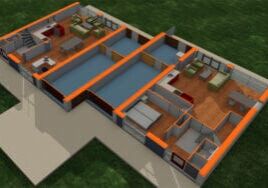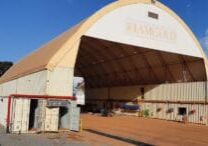Study Quantifies Modular's Wood Waste Savings
A recent study commissioned by MBI and carried out at Colorado State University shows that when it comes to optimizing the circular economics of a construction project, modular is the preferred way to build (when compared to traditional ground-up framing techniques). Now, this isn’t new information for those in the modular community. The very nature of using modular construction techniques is that there is less material waste. But this new study will help quantify that savings.

Killingsworth’s research compared the raw weight of lumber removed from the job site (roll-off weight of dumpsters processed by the waste hauler) with the wood waste created at the modular plant. Those amounts were then divided by the square footage and the total wall height of each project to come up with an average amount of waste.
The study compared the wood waste (in weight) created by two multifamily projects, one using modular construction and the other
traditional stick building. It then calculated the amount of wood waste created by framing activities when compared to both the square
footage and the wall height of each project. This was done in order to provide a consistent comparison, as the ceiling heights on the stick-built project varied.
The research team made several visits to the stick-built site to ensure that wood waste was being properly sorted. At times they found
additional materials and refuse in the wood waste dumpster, so they continued to monitor sorting throughout the project. They also visited the modular manufacturing plant, which had just instituted a waste sorting and reduction process, and confirmed that the process was being followed. Because the process was being followed so closely at the plant, they didn’t revisit it as often.
The results, which will be released at MBI’s 2024 World of Modular, show that modular construction does a better job of keeping wood waste out of the landfills. The research compared the raw weight of lumber removed from the job site (roll-off weight of dumpsters processed by the waste hauler) with the wood waste created at the modular plant. Those amounts were then divided by the square footage and the total wall height of each project to come up with an average amount of waste.
When asked if he was surprised by this result, John Killingsworth, associate professor in the construction management program at CSU, said no. “To be a good scientist you want to be unbiased and have an open mind to accept whatever the data says, and we were. We took two measurements, square footage and ceiling height, to ensure that the data is compared equally. But, no, I wasn’t really surprised.”
The results stand even though modular construction uses more overall lumber than stick framing.
By its nature, modular multifamily developments have twice the ceilings, floors, and walls as stick framing. This is one of the major advantages of using modular, as it reduces noise transmission, leading to quieter living spaces.
The wood waste study was primarily backed by MBI with some assistance from the university. Killingsworth hopes modular construction companies and designers will use this data to market the advantages of modular construction and help grow its market share.
Killingsworth comes to his teaching role with a background in the trades. He worked in the field for 16 years and gained skills in both project management and site management, before going back to school to get his advanced degree. After earning his PhD at the University of Nebraska, he taught in Wisconsin for a few years before moving to Colorado State University.
He is no stranger to modular construction or construction research. During his time in Nebraska, he worked under a Department of Labor grant to provide workforce development focused on modular construction. Then, after he moved to Colorado, he participated in a Department of Energy grant-funded study that compared the energy performance of traditional stick-built multifamily construction with modular, specifically in areas where energy codes are strict (California, Pennsylvania, and Seattle, Washington). The final results of this study, which will be released soon, show that modular performed better. And the relationships with modular builders that were created in that study were leveraged in the recent MBI study on wood waste.
Killingsworth uses his early experiences in the field to give his students context to what they’re learning. The construction program at CSU focuses on the dynamics of construction management at many levels, including superintendent, project manager, and during preconstruction. Topics include estimating, scheduling, contracts, quantity take offs, BIM tools, and construction finance. Students are required to complete two summer internships, which gives them more exposure to the real world and helps with job prospects. The majority of CSU graduates will go into commercial construction management, whether for general contractors or trade contractors.
As far as future research is concerned, Killingsworth hopes that the industry will look at the potential waste savings for other building materials, like steel, or product packaging, like cardboard and Styrofoam. He’d also like to see the industry study the labor savings of modular versus traditional construction. “We don’t really have any empirical data to speak to that. And if we’re going to have a true conversation on circular economics, it’s not just materials, but we’ve got to look at labor efficiencies and the financial impact.”
“We can argue about the improved quality of modular construction, the better energy performance, the lower environmental impact, and the reduced waste, and those are easy arguments to win. But ultimately, if the owner can’t make as much money, then it’s difficult to change their mind. So that’s why I would love to be able to specifically say modular construction is actually equal to or less expensive than traditional construction when you consider the time value of money and lifecycle costs.”
Killingworth intends to use his upcoming sabbatical next year to dive into more specific research on circular economics and construction. A circular economy looks to keep products and materials in service for as long as possible. It focuses on reducing material use, redesigning materials and products to be less resource intensive, and recapturing waste as a resource to manufacture new materials and products. In 2009, the EPA and other federal government agencies adopted a sustainable materials management approach that embraces circularity. The ultimate goal is to transform how we view and handle natural resources, materials and products, and waste. Their vision is a waste management system that is inclusive, more equitable, and reflects the urgency of the climate crisis. Modular construction can be at the forefront of this vision.
Only at World of Modular:

Waste Reduction Practices in Multifamily Construction
John Killingsworth, Associate Professor, Department of Construction Management, Colorado State University
Modular, offsite, and prefabrication practices are growing at a faster pace than traditional construction methods because these innovative solutions address concerns around workforce limitations, material supply-chain, safety, and quality. Past research efforts have typically focused on the qualitative rather than quantitative aspects of modular construction. This research gap provides an opportunity to leverage existing relationships with developer and modular communities to truly measure the quantitative benefits of offsite construction.
Colorado State University has completed a comparative study seeking to specifically measure framing material waste produced during a traditional site-built multifamily project and a modular offsite-built multifamily project. This comprehensive research outlines the significant limitations that exist in traditional building and waste management systems, and the increasing advantages that modular construction practices have in these processes. The research will provide actionable data for modular construction experts and novices alike.
About the Author: Dawn Killough is a freelance construction writer with over 25 years of experience working with construction companies, subcontractors and general contractors. Her published work can be found at dkilloughwriter.com.
More from Modular Advantage
DORÇE Navigates Mountainous Terrain, Extreme Weather to Help Rebuild Türkiye
The February 6 earthquakes in 2023 were enormous. In response, DORÇE moved quickly, obtaining a government bid to help create housing and multipurpose structures—both temporary and permanent—for earthquake victims and laborers hired for reconstruction efforts.
Modern Desert Oasis: Building Reset Hotel the Modular Way
While the off-site construction part of the Reset Hotel project has been carefully controlled and with every necessity close at hand at BECC Modular’s factory in Ontario, Canada, the remote location of the project site has created additional challenges for the on site portion of the build.
Revisiting Yellowstone Canyon Village—a Groundbreaking Modular Construction Feat—Ten Years On
With such a short building period due to impending cold, it made the most sense for park developer Xanterra to pursue modular. Yellowstone’s high visitor traffic also required some odd transportation scheduling, as traffic from the West Yellowstone entrance determined the times when trucks could unload modules. Guerdon was up to the challenge.
Built for Brutal Cold, This Modular Office Building Shines
Houlton, the county seat of Aroostook County, Maine, is a small town with a population of about 6,000 residents. Situated along the border between the U.S. and Canada, what the town is most known for is bitterly cold winters. When the U.S. Border Patrol needed new office space, a modular building approach from Modular Genius offered the perfect solution.
Panel Replacement Adds Years of Life to Navy Vessel
Panel Built, Inc., recently replaced all the wall and roof panels on a two-story US Navy barge deck house that the company had originally installed 30 years ago, giving the vessel new life. Now, the commanding officer of the unit that uses the barge said the difference between the condition and appearance from when the barge left their facility to when the project was complete was beyond his expectations of what was possible.
True Modular Building Seeks to Revolutionize Housing. It’s Next Stop: MBI’s World of Modular Europe
True Modular Building (TMB) specializes in crafting attainable, eco-friendly, and comfortable build-to-rent (BTR) housing with modern designs and customizable features, ensuring that residents feel at home both today and tomorrow.
From Toronto to Suriname: A Global Modular Building Story
When I AM Gold – a Canadian gold mining operation based in Toronto, Ontario – wanted to expand its mining operations in Suriname, it knew it would also need to expand its infrastructure. More specifically, they needed to build a mechanical services compound that would allow their local crews to maintain and equipment critical to their mining operations. They also knew that it would be a challenge.
There Were a “Sea of Challenges” for this Modular, Island Development
Question: Can modular construction be used to build a series of affordable, unique housing buildings, all styled to look like they were built in 1845, on an
island that caters to the wealthy? The answer is, of course, yes, but how the
team at Signature Building Systems and KOH Architecture got there is quite a story.
America’s Construction Economy: A Race Against Time
If the economy has been able to handle higher interest rates thus far, undoubtedly it will be able to manage the lower interest rates to come. But many economists are pointing out that the Federal Reserve may already be too late to the game. While they gradually reduce interest rates, the U.S. economy could quickly decelerate, at least based on theoretical grounds if not on the most recent data releases, culminating in that long-predicted recession. Only time will tell.
Top Five Benefits of Modular Office Space
Modular office spaces are transforming how businesses think about their work environments. These innovative structures offer a mix of flexibility, efficiency, and sustainability, making them a smart choice for companies looking to gain an advantage.










